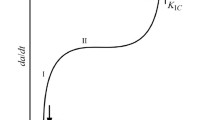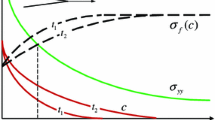Abstract
This paper analyzes the effect of process history on K-dominance condition in hydrogen assisted cracking. The performed study of stress-strain assisted diffusion reveals that hydrogenation of the fracture process zone is not a purely K-driven local autonomous phenomenon. Hydrogenation and crack growth are shown to be coupled processes, one influencing the other. Consequently, particular histories of stress intensity factor K and crack size evolutions affect crack growth rate ν that can occur at the same instantaneous K-value in a given material. Thus the crack growth kinetics curve ν=ν(K) is not unique as an intrinsic material property must be.
Similar content being viewed by others
References
Ahmad, J. and Ashbaugh, N.E. (1982). Constant K I crack propagation test specimens. International Journal of Fracture 19, 115–129.
Akhurst, K.N. and Baker, T.J. (1981). The threshold stress intensity for hydrogen-induced crack growth. Metallurgical Transactions A12, 1059–1070.
Au, J.J. and Birnbaum, H.K. (1978). Hydrogen effects in the deformation of iron whiskers. Scripta Metallurgica 12, 457–459.
Beachem, C.D. (1972). A new model for hydrogen assisted cracking (‘hydrogen embrittlement’). Metallurgical Transactions 3, 437–451.
Broberg, K. (1971). Crack-growth criteria and non-linear fracture mechanics. Journal of the Mechanics and Physics of Solids 19, 407–418.
Celis, B., Argon, A.S. and Yip, S. (1983). Molecular dynamics simulation of crack tip processes in alpha-iron and copper. Journal of Applied Physics 54, 4864–4878.
Doig, P. and Jones, G.T. (1979). The critical stress criterion for gaseous hydrogen embrittlement. Journal of Materials Science 14, 1440–1446.
Flis, J. and Smialowski, M. (1979). Hydrogen embrittlement of polycrystalline iron whiskers. Scripta Metallurgica 13, 641–643.
Gangloff, R.P. (1988). Crack tip modelling of hydrogen environment embrittlement: Application to fracture mechanics life prediction. Materials Science and Engineering A103, 157–166.
Gell, M. and Robertson, W.D. (1966). An analysis of plastic deformation around a stationary cleavage cracks. Acta Metallurgica 4, 481–490.
Gerberich, W.W., Chen, Y.T. and St.John, C. (1975). A short-time diffusion correlation for hydrogen-induced crack growth kinetics. Metallurgical Transactions A6, 1485–1498.
Gerberich, W.W., Oriani, R.A., Lii, M.-J., Chen, X. and Foecke, T. (1991). The necessity of both plasticity and brittleness in the fracture thresholds of iron. Philosophical Magazine A63, 363–376.
Goldenberg, T., Lee, T.D. and Hirth, J.P. (1978). Ductile fracture of U-notched bend specimens of spheroidized AISI 1095 steel. Metallurgical Transactions A9, 1663–1671.
Hanninen, H.E., Lee, T.C., Robertson, I.M. and Birnbaum, H.K. (1993). Direct observations on hydrogen effects on fracture of A533B steel. Corrosion-Deformation Interactions CDI'92. (Edited by T. Magnin and J.M. Gras), Les editions de physique, Les Ulis, 377–388.
Hirth, J.P. (1996). The role of hydrogen in enhancing plastic instability and degrading fracture toughness in steels. Hydrogen Effects in Materials (Edited by A.W. Thompson and N.R. Moody), TMS, Warrendale, PA, 507–522.
Hirth, J.P. and Johnson, H.H. (1976). Hydrogen problems in energy related technology. Corrosion 32, 3–15.
Hudak Jr., S.J. and Wei, R.P. (1979). Consideration of nonsteady state crack growth in materials evaluation and design. In Structural Mechanics in Reactor Technology. Transactions of the 5th International Conference, Berlin, 1979, Amsterdam, G5/5 1–7.
Itatani, M., Miyoshi Y. and Ogura, K. (1991). A numerical analysis of hydrogen concentration at the crack tip in austenitic stainless steel. Journal of the Society of Materials Science Japan 40, 1079–1085.
Jones, A.T. and West, A.J. (1977). Analysis of specimen-fixture interaction for slow crack-growth studies. Engineering Fracture Mechanics 9, 5–15.
Kanninen, M.F. and Gehlen, P.C. (1971). Atomic simulation of crack extension in BCC iron. International Journal of Fracture Mechanics 7, 471–474.
Kanninen, M.F. and Popelar, C.H. (1985). Advanced Fracture Mechanics, Oxford University Press, New York.
Kelly, A., Tyson, W.R. and Cottrell, A.H. (1967). Ductile and brittle crystals. Philosophical Magazine 15, 567–586.
Kharin, V.S. (1987). Crack growth in deformed metals under the action of hydrogen. Soviet Materials Science 23, 348–357.
Kronshtal, O.V. and Kharin, V.S. (1992). Effect of heterogeneity of materials and of heat cycles on diffusion of hydrogen as a factor of risk of development of hydrogen degradation of metals. Soviet Materials Science 28, 475–486.
Landes, J.D. and Wei, R.P. (1973). The kinetics of subcritical crack growth under sustained loading. International Journal of Fracture 9, 277–293.
van Leeuwen, H.-P. (1974). The kinetics of hydrogen embrittlement: A quantitative diffusion model. Engineering Fracture Mechanics 6, 141–161.
Loginow, A.W. and Phelps, E.H. (1975). Steels for seamless hydrogen pressure vessles. Corrosion 31, 404–412.
Louthan, M.R., Caskey, G.R., Donovan, J.A. and Rawl, D.E. (1972). Hydrogen embrittlement of metals. Materials Science and Engineering 10, 357–368.
Lu, M., Pao, P.S., Weir, T.W., Simmons, G.W. and Wei, R.P. (1981). Rate controlling processes for crack growth in hydrogen sulphide for an AISI 4340 steel. Metallurgical Transactions A12, 805–811.
Marichev, V. A. and Rosenfeld, I. L. (1976). Investigation of the mechanism of stress corrosion cracking in high strength steels. Corrosion 32, 423–429.
Needleman, A. and Tvergaard, V. (1983). Crack-tip stress and deformation fields in a solid with a vertex on its yield surface. Elastic-Plastic Fracture: Second Symposium. Vol. 1 — Inelastic Crack Analysis. ASTM STP 803 (Edited by C.F. Shih and J.P. Gudas), ASTM, Philadelphia, I-80–I-115.
Panasyuk, V.V., Andreikiv, A.E. and Kharin, V.S. (1981). Theoretical analysis of crack growth in metals under the action of hydrogen. Soviet Materials Science 17, 61–75.
Panasyuk, V.V., Andreikiv, A.E. and Kharin, V.S. (1987). A model of crack growth in deformed metals under the action of hydrogen. Soviet Materials Science 23, 111–124.
Panasyuk, V.V., Ratych, L.V. and Dmytrakh, I.M. (1984). Fatigue crack growth in corrosive environments. Fatigue of Engineering Materials and Structures 7, 1–11.
Sadananda, K., Jagannadham, K. and Marcinkowski, M.J. (1977). Discrete dislocation analysis of a tensile crack. Physica Status Solidi A44, 633–642.
Sofronis, P. and McMeeking, R.M. (1989). Numerical analysis of hydrogen transport near a blunting crack tip. Journal of the Mechanics and Physics of Solids 37, 317–350.
Thompson, A.W. (1980). Current status of the role of hydrogen in stress corrosion cracking. Materials Science and Engineering 43, 41–46.
Toribio, J. and Kharin, V. (1995). Environmental Damage of Prestressing Concrete by Hydrogen Embrittlement of Steel: The Meaning and Significance of Fracture Mechanics Approach. Interim Report, Materials Science Department, University of La Coruña.
Toribio, J. and Kharin, V. (1996). Predictive capability of fracture mechanics concerning environmentally assisted cracking. InterCorr/96 — 1st Global Internet Corrosion Conference held on ‘The Materials and Corrosion Technology Web Site’. Archived at URL http://www.intercorr.com.
Toribio, J. and Kharin, V. (1997). K-dominance condition in hydrogen-assisted cracking: the role of far field. Fatigue and Fracture of Engineering Materials and Structures 20, 729–745.
Turnbull, A. (1992). Test methods for environment assisted cracking. British Corrosion Journal 27, 271–289.
Vladimirov, V.I. (1984). Physical Nature of the Strength of Metals, Metallurgiya, Moscow, (in Russian).
Waisman, J.L., Sines, G. and Robinson, L.B. (1983). Diffusion of hydrogen in titanium alloys due to composition, temperature, and stress gradients. Metallurgical Transactions 4, 291–302.
Wanhill, R.J.H. (1991). Fracture Control Guidelines for Stress Corrosion Cracking of High Strength Alloys. NLR Technical Publication TP 91006, National Aerospace Laboratory NLR, Amsterdam.
Weertman, J. (1981). Crack tip blunting by dislocation pair creation and separation. Philosophical Magazine A43, 1103–1123.
Wei, R.P. (1967). Application of fracture mechanics to stress-corrosion cracking studies. In Fundamental Aspects of Stress Corrosion Cracking, Ohio State University, Columbus, 104–112.
Williams, D.P. (1973). A new criterion for failure of materials by environment-induced cracking. International Journal of Fracture 9, 63–74.
Author information
Authors and Affiliations
Additional information
On leave from: Pidstryhach Institute for Applied Mechanics and Mathematics, Lviv, Ukraine
Rights and permissions
About this article
Cite this article
Toribio, J., Kharin, V. The Effect of History on Hydrogen Assisted Cracking: 1. Coupling of hydrogenation and crack growth. International Journal of Fracture 88, 233–245 (1997). https://doi.org/10.1023/A:1007442623667
Issue Date:
DOI: https://doi.org/10.1023/A:1007442623667




